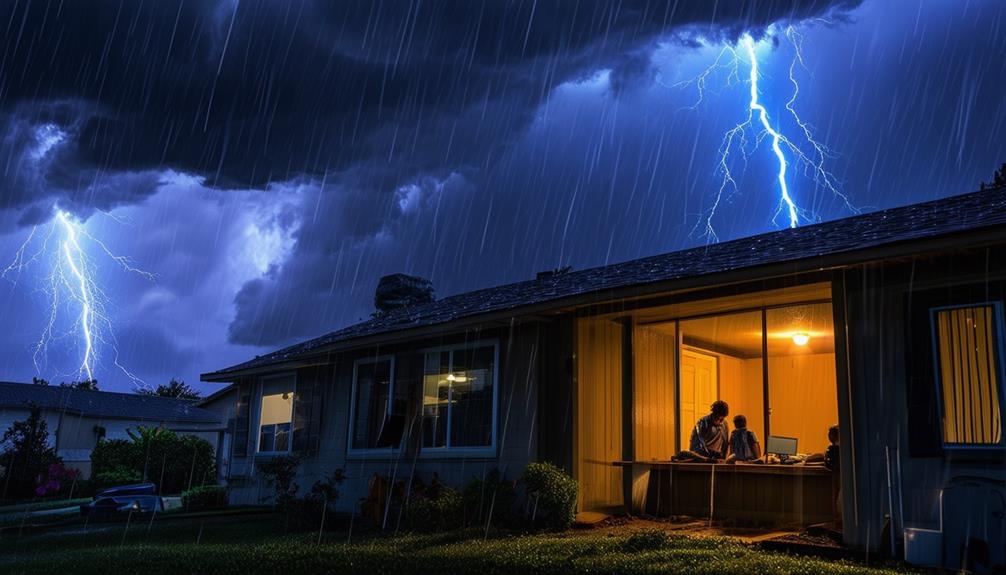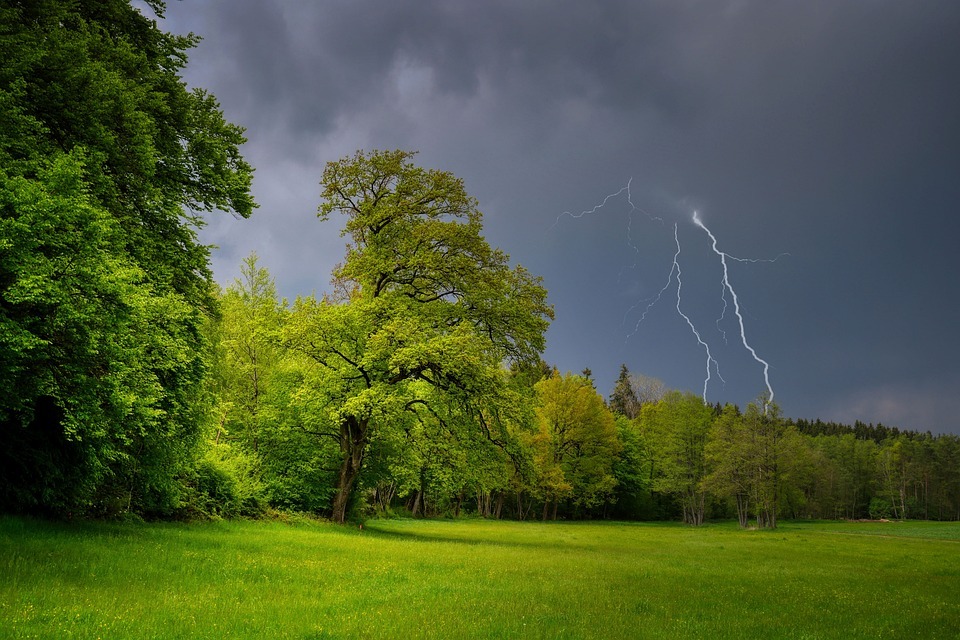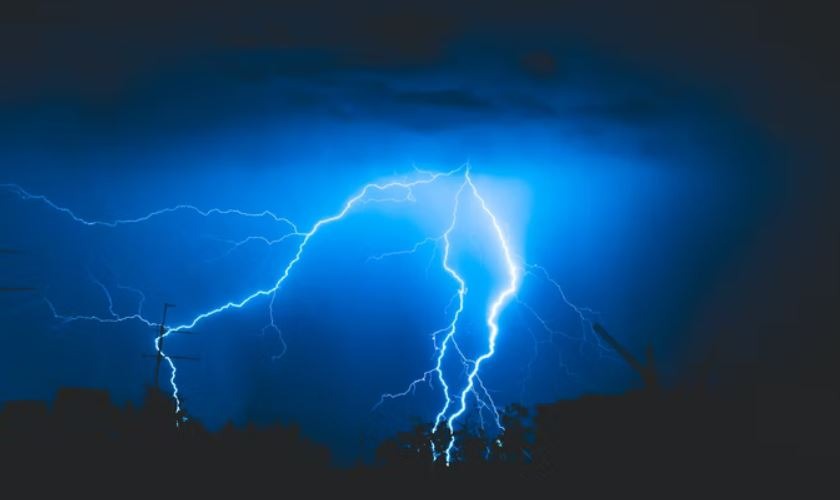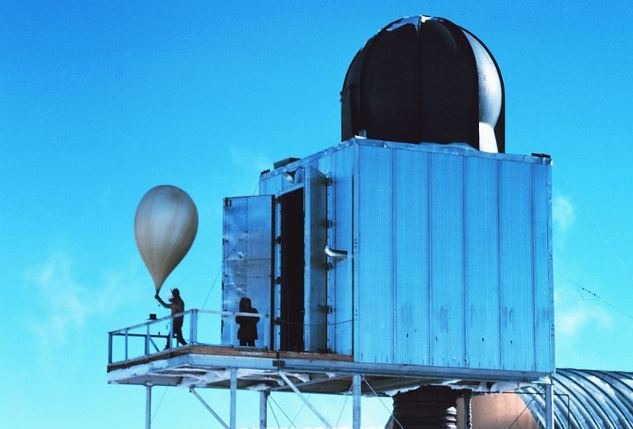Why Does the Sky Sometimes Turn Green During Storms?
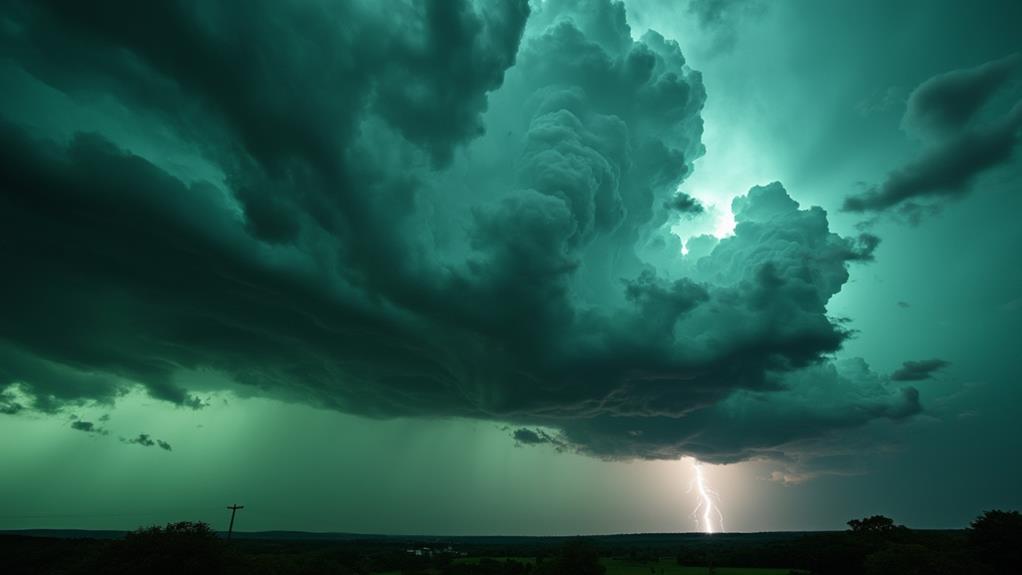
When the sky turns an eerie shade of green during a storm, you're witnessing a fascinating atmospheric phenomenon. This occurs due to the scattering of sunlight by water droplets and ice particles in dense thunderstorm clouds. These thick clouds, filled with moisture and hail, scatter light in a way that amplifies green hues. While some believe this green tint signals an impending tornado, it's not always the case. So, what exactly causes this green sky, and why does it often accompany severe weather? Let's delve into the science and misconceptions behind this striking visual cue.
Visible Light Spectrum
Understanding the visible light spectrum is essential to grasp why the sky can turn green during storms. The visible light spectrum ranges from 380 to 750 nanometers, covering colors from violet to red. Each color corresponds to a different wavelength, with green sitting roughly in the middle. Changes in weather conditions, especially during storms, can dramatically alter the light you see.
Storms often introduce various particles into the air, such as dust, smoke, and water droplets, which interact with sunlight. This interaction causes the light to scatter. Under normal conditions, the sky appears blue because blue light scatters more than other colors due to its shorter wavelength. However, during a storm, dense clouds and particles scatter light differently.
As the sun's angle changes, particularly when it is low in the sky, and storm conditions intensify, the scattering process can favor wavelengths in the green part of the spectrum. This is why you might notice a green tint during severe weather. The storm clouds and particulates create a unique environment that enhances the prominence of green light, serving as a visual cue that unsettled weather is present.
Atmospheric Light Scattering
A green sky during a storm occurs due to sunlight scattering off water droplets and ice particles in thick clouds. Smaller droplets scatter blue light, while larger ones scatter yellow and green, producing the greenish hue. The density of the clouds and their moisture content enhance this effect, particularly in the late afternoon or at sunset.
Sunlight and Water Droplets
As a storm approaches, the sky might take on an eerie green hue, a phenomenon rooted in the interplay of sunlight and water droplets. This green sky effect is primarily due to the scattering of sunlight by water droplets and ice particles within deep thunderstorm clouds. Smaller raindrops scatter blue light more effectively, while larger droplets can combine to reflect yellow and green light, contributing to the overall green appearance.
When sunlight passes through these thick storm clouds, it undergoes significant absorption and reflection of different wavelengths. This process intensifies the green color, especially when the angle of sunlight is low, such as during sunrise or sunset. At these times, the sunlight interacts distinctly with the storm clouds, enhancing the green hue.
Atmospheric conditions also play a crucial role. The presence of moisture and instability in the air is essential for forming the deep thunderstorm clouds that exhibit this green sky effect. These conditions ensure that the thunderstorm clouds are dense enough to scatter sunlight effectively, creating the striking green sky phenomenon observed during intense storms.
Cloud Thickness Influence
The green hue of the sky during storms isn't solely due to sunlight and water droplets; cloud thickness significantly influences this phenomenon. When thunderstorm clouds deepen, they enhance the potential for light scattering, intensifying the green appearance of the sky. This scattering occurs as sunlight interacts with water droplets and ice particles within these clouds.
Thicker clouds provide more opportunities for light to scatter. Smaller water droplets typically scatter blue light, resulting in a blue-green shade, while larger droplets can produce a yellow-green hue. Together, these interactions contribute to the overall green skies observed during a storm.
Atmospheric conditions are crucial. High moisture content and considerable cloud depth are essential for these green skies to become visible. These factors enable the scattering and absorption of different wavelengths of light, leading to the distinct green tint.
As thunderstorms develop and cloud thickness increases, the likelihood of the sky turning green becomes more pronounced. This phenomenon is particularly noticeable when the sun is low in the sky, such as during late afternoon or sunset, enhancing the dramatic effect of green skies.
Role of Thunderstorms
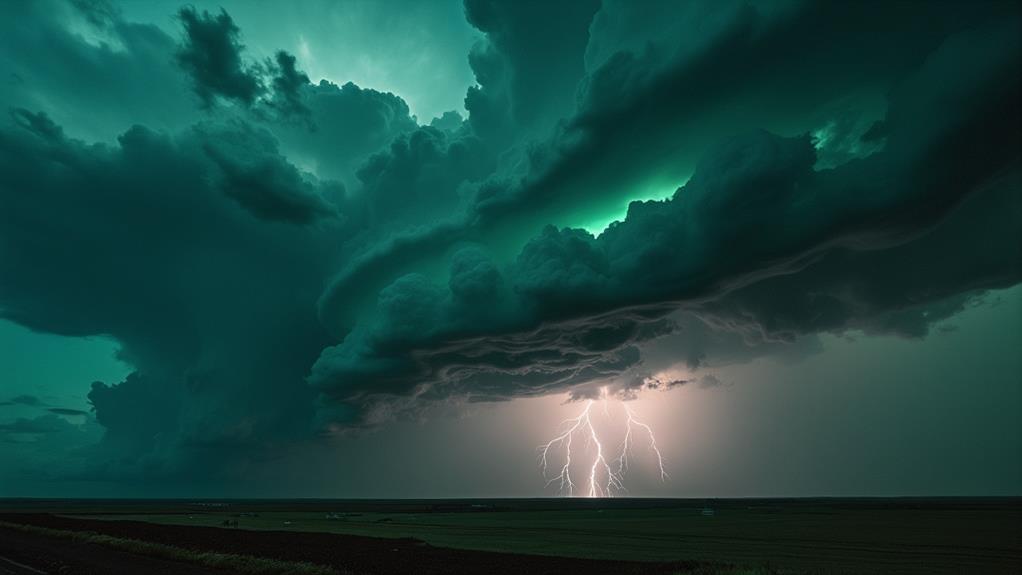
Thunderstorms play a crucial role in why the sky sometimes turns green. When thunderstorm clouds gather, they often bring with them high moisture content and deep cloud structures, creating the perfect conditions for green skies. The large water droplets and ice particles within these clouds scatter sunlight in a unique way. This scattering of sunlight, especially during the late afternoon or sunset, can produce a striking green hue in the sky.
Severe weather events are typically associated with these green skies. Thunderstorms capable of producing large hail and intense rainfall are particularly prone to causing this phenomenon. The green color is a visual indicator that you're dealing with a storm that has the potential for severe weather. However, it's vital to understand that while green skies can signal the possibility of severe weather, they don't necessarily mean a tornado will form. Other atmospheric conditions must align for that to happen.
Green Sky Indicators
When observing a sky tinged with green, you are likely witnessing an indicator of severe weather. This mesmerizing yet eerie phenomenon often precedes intense thunderstorms, serving as a visual cue to prepare for potentially harsh conditions.
- High Water and Ice Content in Clouds: The green sky effect results from the scattering of blue light by raindrops and ice particles within towering thunderstorm clouds. These clouds, rich in water and ice, contribute to the unique coloration.
- Specific Atmospheric Conditions: For a green sky to appear, certain atmospheric conditions must align. The green hue is most visible when the sun is low in the sky, such as late afternoon or early evening, which enhances the scattering process.
- Deep Thunderstorm Clouds: The thickness of thunderstorm clouds plays a crucial role in creating the green sky effect. Deep, dense clouds with large droplets intensify the green coloration, indicating the potential for severe weather.
While a green sky often suggests severe weather, it does not guarantee tornadoes. By recognizing these indicators, you can better prepare for an impending storm and take necessary safety measures.
Misconceptions and Myths
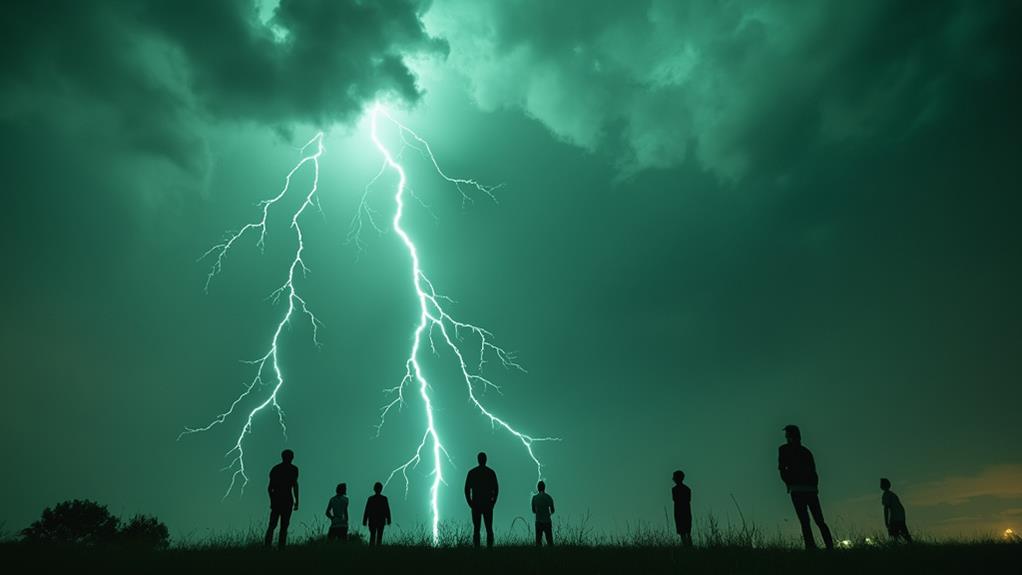
While recognizing the indicators of severe weather, it's likewise essential to address common misconceptions and myths surrounding the green sky phenomenon. A widespread belief is that a green sky always signals an imminent tornado. However, this is a misconception. The green hue is more commonly associated with severe thunderstorms and doesn't guarantee tornado formation.
Another myth rooted in folk wisdom is the idea that a green sky indicates unnatural occurrences, like tornadoes sucking up frogs and grasshoppers. Such explanations lack scientific backing and can lead to misunderstandings about weather phenomena. In reality, the green color results from specific atmospheric conditions, including the scattering of sunlight by water and ice particles in deep thunderstorm clouds.
Misinterpreting the color of the sky can create unnecessary panic. Many thunderstorms show green hues without producing tornadoes or extreme weather.
Educating yourself about the actual scientific causes behind a green sky can help dispel myths, reducing fear and misinformation. Understanding the real reasons behind these atmospheric conditions can greatly improve your storm preparedness.
| Myth | Reality |
|---|---|
| Green sky always means tornado | Green sky indicates severe thunderstorms, not necessarily tornadoes |
| Tornadoes suck up frogs | No scientific evidence supports this myth |
| Green sky is unnatural | Green hue is due to scattering of sunlight by water and ice in thunderclouds |
| Green sky equals extreme panic | Many green sky thunderstorms don't result in extreme weather |
Safety Precautions
If the sky turns green, seek immediate shelter as this usually indicates severe weather. Monitor local weather alerts to stay updated on any changes. Ensure you have a prepared emergency kit and a communication plan with your family to ensure everyone's safety.
Seek Immediate Shelter
A green sky is a critical warning sign of severe weather, such as thunderstorms capable of producing hail or tornadoes. Immediate action is essential to ensure your safety. Follow these steps:
- Seek Shelter Indoors: Move inside right away. Avoid windows and choose a secure location, like a basement or an interior room without windows.
- Avoid Unstable Structures: If outdoors and away from a sturdy building, seek refuge in a vehicle. Avoid mobile homes or temporary structures, as they offer little protection.
- Emergency Preparedness: Severe storms can develop rapidly. Have an emergency kit ready with essentials like water, food, a flashlight, and a radio for updates.
Monitor Weather Alerts
Monitoring weather alerts is crucial when the sky turns green during storms, as this unusual hue often indicates severe weather conditions such as hail or tornadoes. Keeping up with local weather updates helps you stay ahead of potential dangers. The National Weather Service (NWS) is a reliable source for timely updates and warnings, so make sure to follow their alerts during intense weather events.
Additionally, using weather apps that provide real-time notifications for severe thunderstorms is an effective way to stay informed. When you notice a green sky, these alerts can be vital for giving you enough time to seek shelter. If you observe a green sky, it's essential to prepare for severe weather immediately, which includes knowing local emergency procedures and having a safety plan in place.
Plan Emergency Actions
Seeing a green sky during a storm is a clear indication to take immediate action for your safety, as severe storms, including tornadoes or large hail, often follow this phenomenon. Here's how you can prepare and stay safe:
1. Stay Informed: Monitor local weather alerts and updates from the National Weather Service (NWS). Their timely information can be lifesaving, keeping you aware of storm developments and necessary precautions.
2. Prepare an Emergency Kit: Ensure you have a well-stocked emergency kit. Essential items include:
- Water and non-perishable food
- A flashlight and extra batteries
- A first aid kit
This guarantees you have the basic necessities if you need to shelter for an extended period.
3. Designate a Safe Shelter: Identify a safe location in your home, such as a basement or an interior room on the lowest floor. Make sure everyone in your household knows where to go when a green sky signals a severe storm is imminent.
Educate your family on recognizing storm signs and the importance of quick action. By being prepared, you can greatly improve your safety during these unpredictable weather events.

